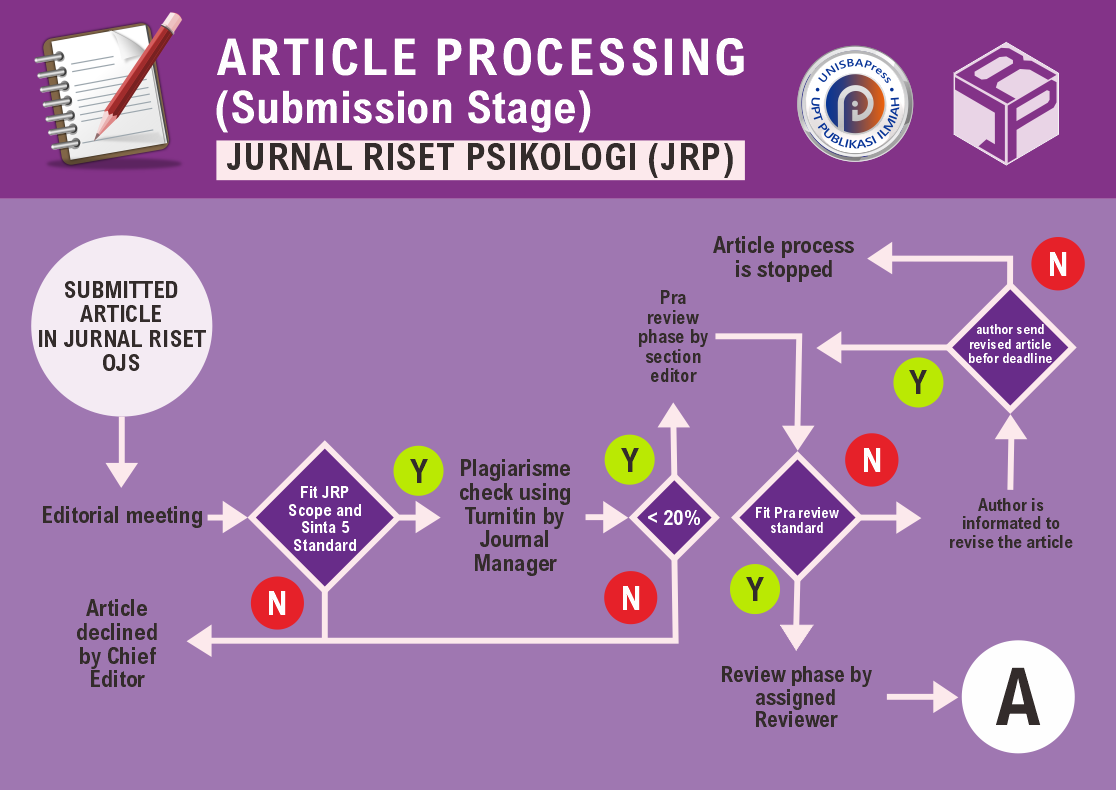Benarkah Bullying Victim Mengancam Interaksi Sosial Remaja?
DOI:
https://doi.org/10.29313/jrp.v2i2.1594Keywords:
Bullying victim, Interaksi sosial, RemajaAbstract
Abstract.Individual who was ostracized in the social environment tend to have difficulty in living friendships so they tend to spend a lot of time alone and become targets for various aggressive behavior such as bullying victims. Bullying victim had several types, one of them was the type of teasing (satire), namely mocking, insulting, harassing, and shouting, so that they have negative impact on social interaction on adolescents. While social interaction was the key to all social life and good social interaction skills. It is needed when hanging out with people around so as to form a friendship for teenagers. This study aims to examine the relationship between social interaction and bullying victim in Riau teenagers. The subjects in this study were 210 respondents, 46 male and 164 female, Riau teenagers with age range of 18-24 years. It used purposive sampling to collect sample. The result of this study indicates that there was a significant relationship between social interaction and bullying victims in Riau adolescents, It means that the research hypothesis is accepted. The implication of this research that it was known that bullying victims really need social interaction in order to feel brave or not experience difficulties when in their surroundings.
Abstrak. Individu yang dikucilkan dalam lingkungan sosial memilih menghabiskan banyak waktu sendirian sehingga menjadi sasaran berbagai tingkah laku agresif, disebut sebagai bullying victim. Bullying victim memiliki beberapa tipe salah satunya adalah tipeteasing : mengejek, menghina, melecehkan, meneriaki. Sehingga berdampak buruk terhadap interaksi sosial remaja. Sementara interaksi sosial kunci dari semua kehidupan sosial dan interaksi sosial yang baik dibutuhkan ketika bergaul dengan lingkungan sekitar sehingga membentuk suatu pertemanan bagi remaja.Tujuan penelitian untuk melihat hubungan antara interaksi sosial dengan bullying victim pada remaja Riau. Subjek penelitian ini sebanyak 210 responden yakni 46 laki-laki dan 164 perempuan remaja Riau dengan rentang usia 18-24 tahun. Teknik sampel menggunakan purposive sampling. Hasil penelitian ini menunjukan adanya hubungan signifikan interaksi sosial dengan bullying victim pada remaja Riau, demikian hipotesis penelitan diterima. Implikasi penelitian ini, maka diketahui bahwa bullying victim sangat memerlukan interaksi sosial agar individu tidak mengalami kesulitan saat berada di lingkungan sekitarnya.
References
R. Marliani, psikologi perkembangan. Pustaka Setia, 2015.
R. Marliani, Psikologi Perkembanga. Pustaka Setia, 2015.
Y. Jahja, Psikolog Perkembangan. Prenadamedia group, 2011.
W. E. Setyowati, D. Heppy, and A. R. Setiani, “Hubungan Antara Perilaku Bullying ( Korban Bullying ) Dengan Kemampuan Interaksi Sosial Pada Remaja SMA,” Proceeding Unissula Nurs. Conf., no. Nurse Roles in Providing Spiritual Care in Hospital, Academic and Community, pp. 174–179, 2017.
I. Chalifatiyanti, “Terapi Kelompok untuk Menurunkan Kecenderungan Perilaku Bullying Pada Siswa SMP,” Pers. Psikol. Indones., vol. 6, no. 1, pp. 1–10, Oct. 2018, doi: 10.30996/persona.v6i1.1626.
Z. Ulya, “Efektivitas Pelatihan ‘Care Teacher, Fight Bullying’ untuk Meningkatkan Keterampilan Pembinaan Bullying pada Guru Sekolah Dasar,” Analitika, vol. 11, no. 2, p. 144, 2019, doi: 10.31289/analitika.v11i2.2957.
M. puri Kusuma, “perilaku school bullying pada siswa sekolah dasar negeri dalengan 2,” vol. 4, no. 1, pp. 64–75, 2014.
vitri angraini Emi, R., Syahrial, & Hardi, “Hubungan Perilaku Bullying Dengan Kemampuan Interaksi Sosial Siswa Kelas V Sd Negeri 37 Pekanbaru,” Indones. Res. J. Educ., vol. 1, no. 1, pp. 1–10, 2021.
KPAI, “sekretariatan,” 2021. https://bankdata.kpai.go.id/tabulasi-data/data-kasus-pengaduan-anak-2016-2020. KPAI R.N
N. Andriani, V. Elita, and S. Rahmalia, “Hubungan Bentuk Prilaku Bullying Dengan Tingkat Stres Pada Remaja Korban Bullying,” Progr. Study Ilmu Keperawatan, pp. 426–435, 2011.
R. P. Pratiwi, “The Corelation Between Bullying With The Students Social Skill Of 3 Rd Grade In Elementary School Of Minomartani 6 Sleman,” J. Pendidik. Guru Sekol. Dasar, vol. 2, no. 5, pp. 141–149, 2016.
Rizki Nur Khalifah, “Hubungan Perilaku Bullying dengan Kemampuan Interaksi Sosial Siswa Kelas V SD Negri 3Bandar Sakti Lampung Tengah,” Director, vol. 15, no. 29, pp. 7577–7588, 2018.
Sejiwa, Bullying mengatasi kekerasan disekolah dan lingkungan sekitar anak. Grasindo, 2008.
S. Soekanto, sosiologi. jakarta: PT. Raja Grafindo Persada, 2012.
eko A. Sarwono, Sarlito w., Meinarno, Psikologi Sosial. Salemba Humanika, 2009.
J. W. Santrock, life span development jilid1. Erlangga, 2001.
N. Wayan, W. Puspitayanti, M. Sulastri, and G. Sedanayasa, “Hubungan Konsep Diri Dan Interaksi Sosial Terhadap Hasil Belajar Siswa Kelas X Sma Negeri 1 Sukasada Semester Genap Tahun Pelajaran 2013 / 2014,” Ilm. Bimbing. Konseling Undiksha, vol. 2, no. 1, pp. 1–10, 2014.
S. Andriyansah, “Hubungan perilaku bullying dengan kemampuan interaksi sosial peserta didik kelas v sd negri 6 mentor barat,” e-conversion - Propos. a Clust. Excell., 2018.
W.A.Gerungan, Psikologi Sosial. PT Refika Aditama, 2004.
M. puri Kusuma, “perilaku school bullying pada siswa sekolah dasar negeri dalengan 2.,” vol. 4, no. 1, pp. 64–75, 2014.
S. Perren and F. D. Alsaker, “Social behavior and peer relationships of victims, bully-victims, and bullies in kindergarten,” J. Child Psychol. Psychiatry, vol. 47, no. 1, pp. 45–57, Jan. 2006, doi: 10.1111/j.1469-7610.2005.01445.x.
Drs. Misfaruddin M.Si., Provinsi Riau Dalam Angka (Bidang Integrasi Pengelolahan dan Diseminasi Statistik (ed.); Bidang Int). BPS Provinsi Riau/BPS-Statistics of Riau Province, 2020.
D. Olweus and S. P. Limber, “Bullying in school: Evaluation and dissemination of the Olweus Bullying Prevention Program.,” Am. J. Orthopsychiatry, vol. 80, no. 1, pp. 124–134, 2010, doi: 10.1111/j.1939-0025.2010.01015.x.
A. S. Mardani, “Terhadap Perilaku Bullying Di Sd Negeri,” naskah Publ., pp. 1–11, 2019.
K. Anwar and Y. Karneli, “The Relationship between Bullying Behavior and Students’ Social Interaction Ability,” J. Neo Konseling, vol. 2, no. 4, p. 2020, 2020, doi: 10.24036/00302kons2020.
S. Taylor, Health psychology sixth edition. Los Angeles: University California, 2006.
P. Petty, R. E., & Briñol, Theories of Social Psychology. In Psikodimensia. 2012.
& S. R. Aprilia Ramadhani, “Depresi Pada Remaja Korban Bullying,” J. Fak. Psikol. Univ. Gadjah Mada, 9(Desember), pp. 73–79, 2013.
J. Nafingah, A. A. B., & Suroso, “Pengaruh behavior skill training terhadap interaksi sosial korban bullying di SMP N 1 Kaligondang kabupaten Purbalingga,” J. Keperawatan Muhammadiyah, pp. 165–170, 2020.













